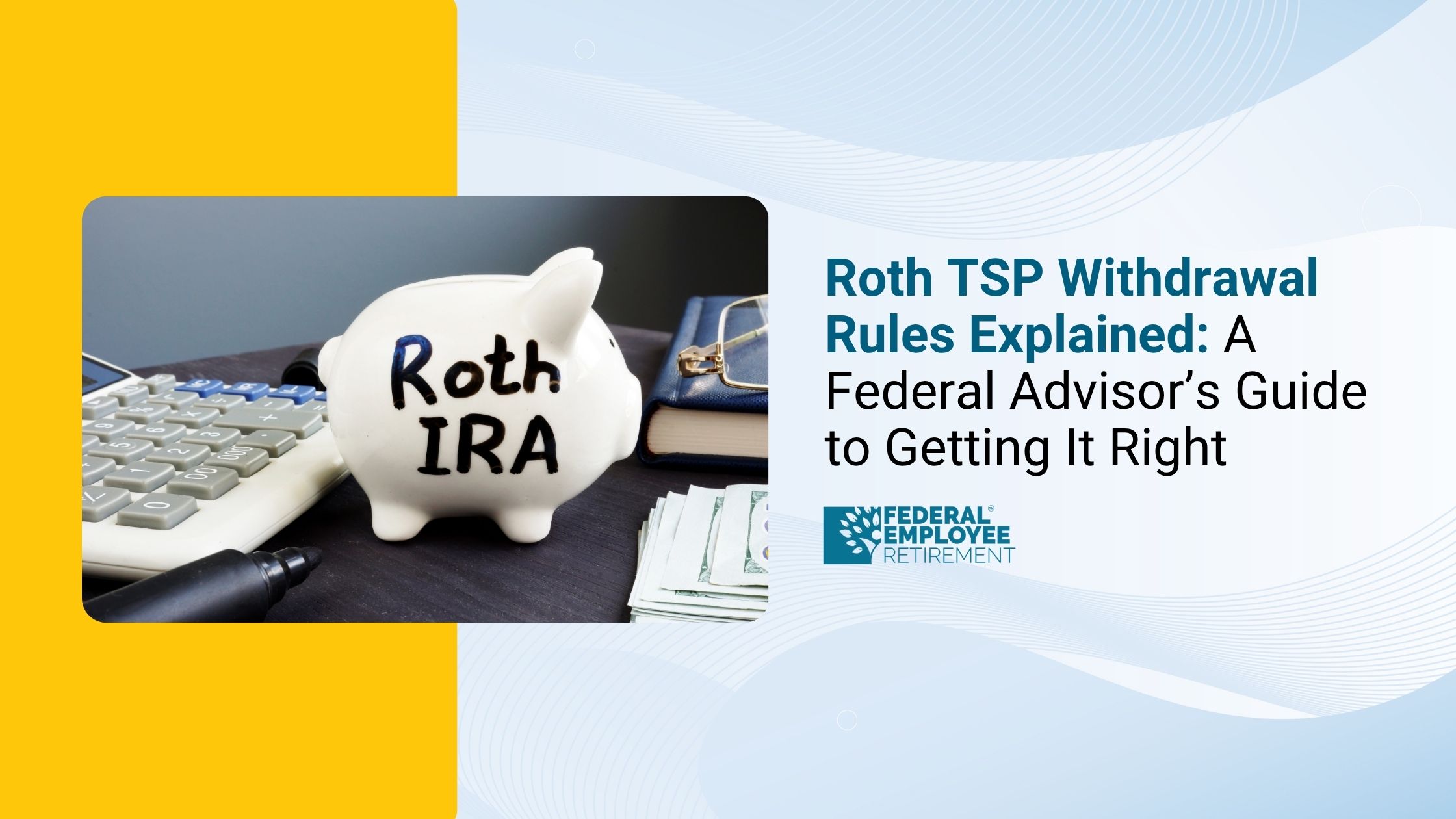You’re not alone; 4,359 federal employees booked their free review.

Roth TSP Withdrawal Rules 2025: Expert Federal Advisor’s Guide
When and How Can You Withdraw from Your Roth TSP and Keep It Tax-Free?
If you’ve contributed to the Roth Thrift Savings Plan (TSP), you’ve already made a smart move toward tax diversification in retirement. But one question comes up again and again:
“When can I actually take the money out and will it really be tax-free?”
Here’s the straightforward answer we share with our clients:
You can withdraw money from your Roth TSP after separating from federal service, and the withdrawals are completely tax-free when two conditions are met:
- You’re at least 59½, disabled, or deceased (for beneficiaries), and
- You’ve had a Roth TSP for at least five tax years since your first contribution.
Meet both, and every dollar contributions and earnings is yours tax-free. Miss either one, and your earnings portion can be taxed and penalized.
In our experience advising thousands of federal employees and retirees, most people understand those two rules. What often trips them up are the fine-print details: spousal consent, withdrawal timing, RMD rules, tax withholding, and rollovers. Those are what we’ll walk through next with clear examples, practical takeaways, and insight from real client situations of Roth TSP Withdrawal Rules.
1. Understanding the Roth TSP (and Why It’s Different)
The Roth TSP works much like a Roth 401(k): you contribute after taxes, and your money grows tax-free. The beauty is that your future qualified withdrawals are not taxed no matter how much your account grows.
We often see employees in their late 40s and 50s shift a portion of new contributions to Roth TSP. The reasoning is simple: you can’t predict future tax rates, but you can control which dollars you’ll owe tax on later.
Advisor Insight:
Many of our clients balance their TSP roughly 60% traditional / 40% Roth by their final five working years. That gives them flexibility to manage taxes in retirement year by year.
2. The Two Key Rules for Tax-Free Roth TSP Withdrawals
To qualify for a tax-free withdrawal, you must satisfy:
- Age Rule: 59½ or older (or disabled/deceased).
- Five-Year Rule: Your first Roth TSP contribution must have been at least five tax years ago.
If you fail either, only your contributions are tax-free not the earnings.
Example:
Mary started contributing to her Roth TSP in 2020 and retired in 2024 at age 61. Because her Roth hasn’t reached the 5-year mark until January 1, 2025, any withdrawals in 2024 would trigger taxes on earnings.
Key Takeaway:
Your Roth TSP “five-year clock” starts January 1 of the year of your first Roth contribution not your hire date or first deposit.
3. In-Service Withdrawals: Think Twice Before Taking Them
You can withdraw from your TSP while still working, but these in-service withdrawals often do more harm than good.
- They permanently reduce your retirement savings.
- Roth earnings withdrawn early (before 59½ and before five years) are taxable and possibly penalized.
- You may need spousal consent.
In practice, we rarely recommend in-service Roth withdrawals.
We’ve seen too many employees drain tax-free growth potential years before retirement only to regret it later.
4. Withdrawing After You Retire or Separate from Service
Once you’ve separated, you have full access to your TSP. You can:
- Take partial withdrawals,
- Set up installment payments, or
- Request a total withdrawal or annuity purchase.
Since 2022, you can decide whether withdrawals come from:
- Your Roth balance,
- Your traditional balance, or
- Pro-rata (a mix of both).
Qualified Roth withdrawals (age + 5 years) are tax-free; traditional withdrawals are taxable as income.
Blogs you must read after to get more knowledge about Roth TSP witdrawl rules
tsp traditional to roth conversion
when can you withdraw from tsp without penalty
Required Minimum Distributions (RMDs)
Thanks to SECURE Act 2.0, Roth TSP balances are no longer subject to RMDs starting in 2024. However:
- Traditional TSP balances still require RMDs.
- Beneficiary participant accounts include both Roth and traditional in RMD calculations.
RMD start age:
- Born before 1951 → Already started.
- Born 1951–1959 → Age 73.
- Born after 1959 → Age 75.
If still employed, your RMD begins April 1 after separation.
Advisor Tip:
If you roll your Roth TSP to a Roth IRA before RMD age, you can eliminate lifetime RMDs altogether.
5. How the TSP Handles Taxes and Payments
Every TSP withdrawal triggers IRS reporting and (sometimes) tax withholding.
What to expect:
- Reported on IRS Form 1099-R each year you withdraw.
- Federal withholding: Applies to the taxable portion (not qualified Roth). You can adjust or waive withholding in My Account.
- No state withholding: TSP doesn’t withhold for state tax, but does report to your state of residence.
- Payment timing: Partial and total withdrawals process daily; installments go out the 15th of each month.
- Payment destination: Must be on file for 7 days before funds can be sent.
- Once sent, withdrawals are final you can’t “return” the money.
Key Takeaway:
Always review your tax withholding settings and confirm your bank info at least a week before submitting a withdrawal.
Don’t Let Your Roth TSP Withdrawals Cost You Thousands

Most federal employees think their Roth TSP money is automatically tax-free until they make one small timing mistake that triggers taxes or penalties.
We’ve seen it happen too often. The rules aren’t complicated but they are unforgiving.
Our latest guide breaks down exactly when and how to withdraw your Roth TSP tax-free, and the strategies smart federal employees are using before year-end to avoid costly surprises.
6. Account Holds and Security Protections
Certain holds can delay or block withdrawals:
- Court orders (divorce, alimony, child support, abuse judgments)
- Federal tax levies
- Criminal restitution orders (MVRA)
- Fraud investigations or account corrections
Even with a hold, your RMDs will still be processed on time.
You can also voluntarily lock your TSP account for extra protection and must use your unlock key to lift the lock before withdrawing.
7. Spousal Rights: A Crucial Federal Detail
Spousal consent rules are strict and easy to overlook.
- Partial withdrawals:
- Married FERS/uniformed participants: spouse must consent (notarized).
- Married CSRS participants: TSP notifies spouse.
- Married FERS/uniformed participants: spouse must consent (notarized).
- Total withdrawals (balance > $3,500):
- Married FERS/uniformed participants: spouse is entitled to a joint life annuity (50% survivor, level payments, no refund).
- To choose another option, your spouse must waive this right (notarized).
- To choose another option, your spouse must waive this right (notarized).
- Married CSRS participants: TSP notifies spouse.
- Married FERS/uniformed participants: spouse is entitled to a joint life annuity (50% survivor, level payments, no refund).
- Combining civilian/uniformed accounts (CSRS):
- Civilian → uniformed: spouse must waive consent for withdrawals.
- Uniformed → civilian: spouse must consent to combine.
- Civilian → uniformed: spouse must waive consent for withdrawals.
Advisor Observation:
Spousal consent issues are one of the most common reasons TSP withdrawal requests get delayed. Double-check before submitting.
8. Rollovers and Transfers: Roth TSP to Roth IRA
Rolling your Roth TSP into a Roth IRA can expand your flexibility and investment choices.
Benefits:
- No RMDs for the account owner.
- Broader investment options.
- Easier coordination with other retirement assets.
Cautions:
- The 5-year clock resets unless you already have an existing Roth IRA open for 5+ years.
- Rollover eligibility depends on whether funds are Roth or traditional.
- Once transferred, the IRA’s rules apply.
Example:
If you’ve never had a Roth IRA and you roll your Roth TSP into one in 2025, your new five-year clock runs until 2030. Opening a small Roth IRA now can start that clock early.
12. Roth TSP Withdrawal Checklist
Before you request a withdrawal, confirm the following:
- Age 59½ (or qualifying exception)
- Five-year rule satisfied
- Separated from service
- Chosen Roth/traditional/pro-rata mix
- Bank info or address on file 7+ days
- Spousal consent or notification confirmed
- RMD timing reviewed
- Withholding preferences updated
- Rollover vs. cash-out decision made
Key Takeaways
- Qualified Roth TSP withdrawals (age + 5 years) are 100% tax-free.
- Roth TSPs no longer have RMDs starting 2024.
- Spousal consent is required for many withdrawals.
- The five-year clock is unique to each plan not transferable.
- Always review tax withholding, payment setup, and state rules before submitting.
Rollovers to Roth IRAs can extend tax benefits and flexibility.
If you’re unsure about when or how to withdraw from your Roth TSP, we can help.
Book a personal consultation to review your Roth timeline, withdrawal options, and tax strategy and make sure every dollar you worked for comes out exactly as you intend.
Final Thoughts
The Roth TSP is one of the most powerful components of your federal retirement plan but it’s also one of the most misunderstood. The rules aren’t overly complex, but the details matter.
In our experience guiding federal employees through retirement, those who plan their Roth withdrawals early checking their five-year rule, coordinating spousal forms, and timing rollovers wisely enjoy smoother transitions and fewer tax headaches.
Sources
- TSP.gov – Taking Money From Your Account
- TSP.gov – Tax Rules About TSP Payments (Booklet)
- [PlanYourFederalRetirement.com – Roth TSP Withdrawal Rules]
- [FedSmith.com – Understanding Roth TSP and Roth IRA 5-Year Rule]
- [NARFE White Paper – TSP and SECURE Act 2.0 Updates, 2024]
Disclaimer
This article is for educational and informational purposes only. It is not intended as tax, investment, or legal advice. Individual circumstances vary, and federal retirement rules can change. Always consult a qualified financial or tax advisor before making decisions regarding your TSP, Roth TSP, or retirement income strategy.


Get Updated
Subscribe to our weekly updates for the latest on retirement planning, federal benefits, exclusive webinars, and more!
Download Federal Retirement: Step-by-step Checklist
This comprehensive guide will help you understand your federal benefits, optimize your savings, and plan for a comfortable future.



.png)







%20A%20Clear%20Guide%20for%20Federal%20Families.jpg)
